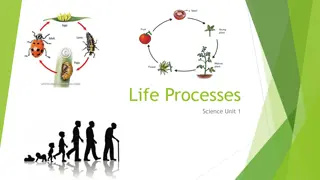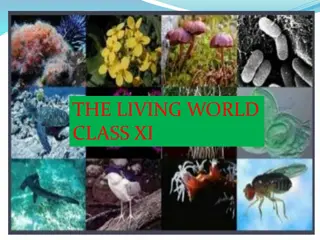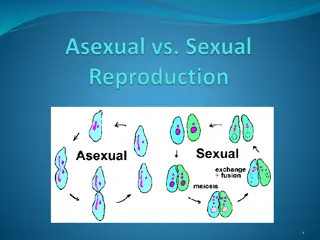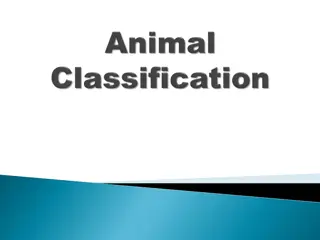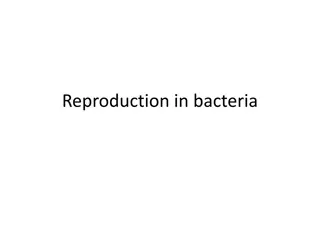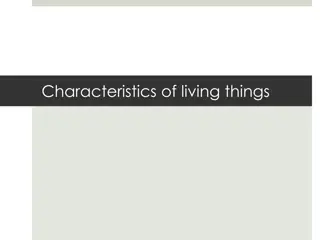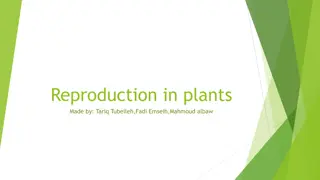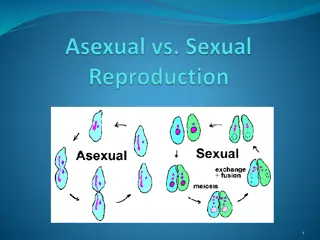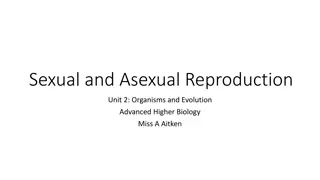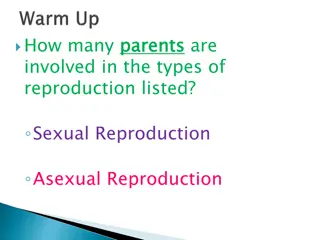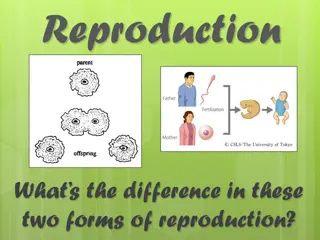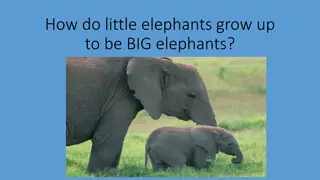Understanding Reproduction in Living Organisms
Reproduction in living organisms involves both sexual and asexual methods, with each having unique processes. Sexual reproduction involves the fusion of genetic material from two individuals, while asexual reproduction results in genetically identical offspring. Different forms of plant reproduction, such as vegetative and flowering, are detailed, along with the role of flower parts in the process. Additionally, the structural adaptations of insect-pollinated and wind-pollinated plants are discussed to illustrate the diversity of reproductive strategies in nature.
Download Presentation

Please find below an Image/Link to download the presentation.
The content on the website is provided AS IS for your information and personal use only. It may not be sold, licensed, or shared on other websites without obtaining consent from the author. Download presentation by click this link. If you encounter any issues during the download, it is possible that the publisher has removed the file from their server.
E N D
Presentation Transcript
Reproduction in Living Organisms
Sexual and Asexual Reproduction The process of creating new living things by fusing the genetic material of two distinct types of individuals (sexes). In the majority of higher organisms, the male sex creates a small, mobile gamete that travels to the larger, stationary gamete created by the female to fuse with it (female). Genetically identical offspring are produced by asexual reproduction. Vegetative reproduction occurs in roots such as corms, stem bulbs, rhizomes, and stolons. Some plants have a process called apomixis whereby the ovule or ovary produces new seeds without needing to be fertilized. Flowering plants reproduce sexually through a process called pollination. Flowers contain male sex organs called stamens and female sex organs called pistils/carpels. The anther is the part of the stamen that contains pollen. Pollen contains the male gametes. Natural methods of asexual reproduction include self-propagation. The different ways in which a plant self propagates are mentioned below: Plants such as ginger, onion, dahlia, potato, grow from the buds present on the surface of the stem.
Part of the Flower Function Sepals A defensive organ that encloses and protects the developing reproductive structures. At maturity, the sepal opens when the flower blooms. Petals The petals attract pollinators. Stamens Stamens are the male reproductive organs of flowering plants. Filaments Carry nutrients to the anther for the development of the anther and pollen grains. Anthers The male reproductive organ in seed plants. Its main function is to produce and disperse pollen. Carpels/Pistils Carpel is the ovule-bearing female reproductive organ of flowering plants and is required to ensure its protection, an efficient fertilization, and the development of diversified types of fruits, thereby it is a vital element of most food crops. Style Generates the pollen tube but also prevents incompatible pollen from entering the ovary. Allows growth of pollen tube and helps it to reach ovary. Stigma The part where the pollen lands and starts the fertilization process. Ovary The ovary contains ovules. Ovules The ovule itself is the reproductive organ that contains the egg cell which later develops into the seed. In angiosperms, the seed develops inside of an ovary, while in gymnosperms the seed develops within the surface of the female cone.
The Structural Adaptations of: Insect-Pollinated: Wind-Pollinated: Insect-pollinated flowers are adapted in the following ways: They are large and have brightly colored or white petals. They are very fragrant so that the insects are attracted by the smell. Presence of nectaries that produce nectar. Wind-pollinated species have evolved a number of reproductive structural traits to adapt them to anemophily. For example, the anthers of some anemophilous species are typically large, and extend on long, flexible filaments to improve effective pollen dispersal.
What are the main advantages and disadvantages between cross and self pollination?
Disadvantages Advantages 1. Self-pollination helps to maintain parental characters or purity of the species. The plant does not need to depend on the pollinating agents. No need of producing a large number of pollen grains. Flowers do not need to develop devices for attracting insect pollinators. It ensures seed production. 1. The seeds are in smaller quantities. New plant varieties cannot be created. Because the endosperm is so little, the seeds produced are feeble. The immunity of the offspring decreases if new characteristics are not introduced. Self-Pollination 2. 2. 3. 3. 4. 5. 1. Pollen grains are being wasted in more significant quantities. Because of the distance barrier, pollination may fail. Cross-pollination has the potential to introduce undesirable traits. It is uneconomical for plants to create huge, scented, nectar-filled flowers to attract insects. 1. New varieties are created as a result of cross-pollination. Seeds are produced in more significant quantities and are more viable. Healthier offsprings are produced. Cross-Pollination 2. 2. 3. 4. 3.
Fertilisation In plants, fertilization is a process of sexual reproduction, which occurs after pollination and germination. Fertilization can be defined as the fusion of the male gametes (pollen) with the female gametes (ovum) to form a diploid zygote. It is a physicochemical process which occurs after the pollination of the carpel. There are four primary steps of fertilization of plants: Pollination, Fertilization Seed Dispersal Germination
Part of the Seed Function The testa of higher plant seeds protects the embryo against adverse environmental conditions. Its role is assumed mainly by controlling germination through dormancy imposition and by limiting the detrimental activity of physical and biological agents during seed storage. Testa Cotyledons They contain reserve food material that provides nourishment to the developing seedling. The function of Cotyledons is to store food for the growing embryo. Radicle Radicle is capable of absorbing water from the soil, which is required for the development of the embryonic plant. Radicle absorbs water and nutrients and supplies to the leaves for starting photosynthesis. Plumule Since the plumule forms the shoot of the plant, it is responsible for performing photosynthesis. Therefore, the plumule helps in the production and transportation of the food to other parts of the plant.
How Certain Environmental Factors Affect Germination of Seeds(Limiting Factors of Germination): Water: When the seed fills with water in a process called imbibition, it activates enzymes to initiate the germination process. On the other hand, too much water can cause seeds to rot instead of developing into a seedling. So, suitable moisture is needed to get the best results. Oxygen: Temperature: Oxygen (O2) in the soil is necessary for the germination of seeds, but it can be reduced by excessive water contents, compaction, compression, and hard surfaces. Reduced O2 concentrations may change the germination success and speed of seeds. Germination rate increases with rises in temperature up to the optimum one and declines at temperatures exceeding it. Plant growth rate increases with rises in temperature from the base to the optimum temperatures and declines at temperatures between the optimum and the ceiling ones.
Citation Parts of a Seed, Their Structure, and Functions with Diagram Fertilization in Plants | Biology, Pollination & Process -Video & Lesson Transcript | Study.com Plumule-The Part of the Seed Embryo -An Overview at BYJU S. Influence of the testa on seed dormancy, germination, and longevity in Arabidopsis https://img.freepik.com/free-vector/diagram-pollination-flowering-plants_1308- 89007.jpg?w=2000 Influence of temperature on seed germination response of fennel -MedCrave online Effect of reduced oxygen concentration on the germination behavior of vegetable seeds | SpringerLink



